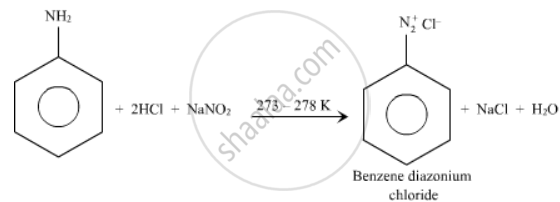Advertisements
Advertisements
Questions
Illustrate the following reaction giving suitable example in each case: Diazotisation
Write the reactions involved in Diazotisation
Solution 1

Solution 2
The process of the formation of the diazonium salt by the reaction of the aromatic amine with the nitrous acid is known as the diazotization reaction

APPEARS IN
RELATED QUESTIONS
Write equations of the following reactions:
Acetylation of aniline
Why is benzene diazonium chloride not stored and is used immediately after its preparation?
Why is aniline soluble in aqueous HCl?
How will you carry out the following conversions?
toluene `->` p-toluidine
How will you carry out the following conversions?
p-toluidine diazonium chloride `→` p-toluic acid
A colourless substance ‘A’ \[\ce{(C6H7N)}\] is sparingly soluble in water and gives a water soluble compound ‘B’ on treating with mineral acid. On reacting with \[\ce{CHCl3}\] and alcoholic potash ‘A’ produces an obnoxious smell due to the formation of compound ‘C’. Reaction of ‘A’ with benzenesulphonyl chloride gives compound ‘D’ which is soluble in alkali. With \[\ce{NaNO2}\] and \[\ce{HCl}\], ‘A’ forms compound ‘E’ which reacts with phenol in alkaline medium to give an orange dye ‘F’. Identify compounds ‘A’ to ‘F’.
Which of the following is the most stable diazonium salt?

Major Product In the above chemical reaction, intermediate "X" and reagent/condition "A" are:
Aniline dissolved in dilute HCl is reacted with sodium nitrate at 0 °C. This solution was added dropwise to a solution containing equimolar mixture of aniline and phenol in dil. HCl. The structure of the major product is:
How will the following be converted? (Give chemical equation)
Aniline to benzene diazonium chloride.
